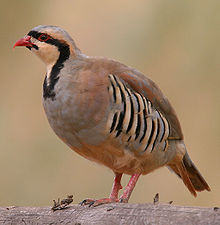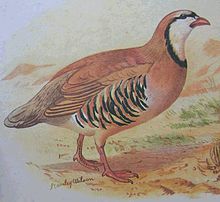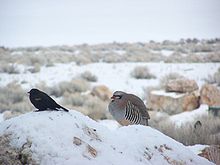- Chukar Partridge
-
Chukar Partridge 
Conservation status Scientific classification Kingdom: Animalia Phylum: Chordata Class: Aves Order: Galliformes Family: Phasianidae Genus: Alectoris Species: A. chukar Binomial name Alectoris chukar
(Gray, 1830)Subspecies - A. c. chukar
- A. c. cypriotes
- A. c. dzungarica
- A. c. falki
- A. c. kleini
- A. c. koroviakovi
- A. c. kurdestanica
- A. c. pallescens
- A. c. pallida
- A. c. potanini
- A. c. pubescens
- A. c. sinaica
- A. c. subpallida
- A. c. werae

Rough distribution of Chukar (green) and related partridges Synonyms Caccabis kakelik
The Chukar Partridge or Chukar (Alectoris chukar) is a Eurasian upland gamebird in the pheasant family Phasianidae. It has been considered to form a superspecies complex along with the Rock Partridge, Philby's Partridge and Przevalski's Partridge and treated in the past as conspecific particularly with the first. This partridge has well marked black and white bars on the flanks and a black band running from the forehead across the eye and running down the head to form a necklace that encloses a white throat. The species has been introduced into many other places and feral populations have established themselves in parts of North America and New Zealand.
Contents
Description
The Chukar is a rotund 32–35 cm (13–14 in) long partridge, with a light brown back, grey breast, and buff belly. The shades vary across the various populations. The face is white with a black gorget. It has rufous-streaked flanks, red legs and coral red bill. Sexes are similar, the female slightly smaller in size and lacking the spur.[2] The tail has 14 feathers, the third primary is the longest while the first is level with the fifth and sixth primaries.[3]
It is very similar to the Rock Partridge (Alectoris graeca) with which it has been lumped in the past[4] but is browner on the back and has a yellowish tinge to the foreneck. The sharply defined gorget distinguishes this species from the Red-legged Partridge which has the black collar breaking into dark streaks near the breast. Their song is a noisy chuck-chuck-chukar-chukar from which the name is derived.[5] The Barbary partridge (Alectoris barbara) has the a reddish brown rather than black collar with the grey throat and face with a chestnut crown they get therened.[6]
Other common names of this bird include Chukker (sometimes spelled as 'Chuker' or 'Chukor'), Indian Chukar and Keklik.
Distribution and habitat
This partridge has its native range in Asia, from Israel and Turkey through Afghanistan to India, along the inner ranges of the Western Himalayas to Nepal. Further west in southeastern Europe it is replaced by the Red-legged Partridge, Alectoris rufa. It barely ranges into Africa on the Sinai Peninsula. The habitat in the native range is rocky open hillsides with grass or scattered scrub or cultivation. It is mainly found at an altitude of 2000 to 4000 m except in Pakistan, where it occurs at 600m.[2][7] They are not found in areas of high humidity or rainfall.[8]
It has been introduced widely as a game bird, and feral populations have become established in the United States Rocky Mountains, Great Basin, high desert areas of California, Canada, New Zealand and Hawaii. Initial introductions into the US were from the nominate populations collected from Afghanistan and Nepal.[9] It has also been introduced to New South Wales in Australia but breeding populations have not persisted and are probably extinct.[10] A small population exists on Robben Island in South Africa since it was introduced there in 1964. [11]
Systematics and taxonomy
The Chukar Partridge is part of a confusing group of "Red-legged Partridges". Several plumage variations within the widespread distribution of the Chukar Partridge have been described and designated as subspecies. In the past the Chukar group was included with the Rock Partridge (also known as the Greek Partridge). The species from Turkey and farther east was subsequently separated from A. graeca of Greece and Bulgaria and western Europe.[12][13]
Subspecies
There are fourteen recognized subspecies:
- A. c. chukar (JE Gray, 1830) - nominate - eastern Afghanistan to eastern Nepal
- A. c. cypriotes (Hartert, 1917) - Island Chukar - southeastern Bulgaria to southern Syria, Crete, Rhodes and Cyprus
- A. c. dzungarica (Sushkin, 1927) - northwestern Mongolia to Russian Altai and eastern Tibet
- A. c. falki (Hartert, 1917) - north central Afghanistan to Pamir Mountains and western China
- A. c. kleini (Hartert, 1925)
- A. c. koroviakovi (Zarudny, 1914) - Persian Chukar - eastern Iran to Pakistan
- A. c. kurdestanica (Meinertzhagen, 1923) - Kurdestan Chukar - Caucasus Mountains to Iran
- A. c. pallescens (Hume, 1873) - Northern Chukar - northeastern Afghanistan to Ladakh and western Tibet
- A. c. pallida (Hume, 1873) - northwestern China
- A. c. potanini (Sushkin, 1927) - western Mongolia
- A. c. pubescens (Swinhoe, 1871) - inner Mongolia to northwestern Sichuan and eastern Qinghai
- A. c. sinaica (Bonaparte, 1858) - northern Syrian Desert to Sinai Peninsula
- A. c. subpallida (Zarudny, 1914) - Tajikistan (Kyzyl Kum and Kara Kum mountains)
- A. c. werae (Zarudny and Loudon, 1904) - Iranian Chukar - eastern Iraq and southwestern Iran
Population and status
This species is relatively unaffected by hunting or loss of habitat. Its numbers are largely affected by weather patterns during the breeding season. The release of captive stock in some parts of southern Europe can threaten native populations of Rock Partridge and Red-legged Partridge with which they may hybridize.[14][15]
Behaviour and ecology
In the non-breeding season, Chukar Partridge are found in small coveys of 10 or more (up to 50) birds. In summer, Chukars form pairs to breed. During this time, the cocks are very pugnacious calling and fighting.[7][8][16][17] During winter they descend into the valleys and feed in fields. The call frequently during the day especially in the mornings and evenings. The call is loud and includes loud repeated "Chuck" notes and sometimes duetting "Chuker" notes. Several calls varying with context have been noted.[18] The commonest call is a "rallying call" which when played back elicits a response from birds and has been used in surveys, although the method is not very reliable.[19][20] When disturbed, it prefers to run rather than fly, but if necessary it flies a short distance often down a slope on rounded wings, calling immediately after alighting.[2][21][22] In Utah, birds were found to forage in an area of about 2.6 km2. and travel up to 4.8 km to obtain water during the dry season. The home range was found to be even smaller in Idaho.[23][24][25]
The breeding season is summer. Males perform tidbitting displays, a form of courtship feeding where the male pecks at food and a female may visit to peck in response. The males may chase females with head lowered, wing lowered and neck fluffed. The male may also performs a high step stiff walk while making a special call. The female may then crouch in acceptance and the male mounts to copulate, while grasping the nape of the female. Males are monogynous.[13] The nest is a scantily lined ground scrape, though occasionally a compact pad is created with a depression in the center. Generally, the nests are sheltered by ferns and small bushes, or placed in a dip or rocky hillside under a overhanging rock. About 7 to 14 eggs are laid.[8][17][26] The eggs hatch in about 23–25 days. In captivity they can lay an egg each day during the breeding season if eggs are collected daily.[27] Chicks join their parents in foraging and will soon join the chicks of other members of the covey.[6]
Chukar will take a wide variety of seeds and some insects as food. It also ingests grit.[21] In Kashmir, the seeds of a species of Eragrostis was particularly dominant in their diet[28] while those in the US favoured Bromus tectorum.[6] Birds feeding on succulent vegetation make up for their water needs but visit open water in summer.[29]
Chukar roost on rocky slopes or under shrubs. In winter, birds in the US selected protected niches or caves. A group may roost in a tight circle with their heads pointed outwards to conserve heat and keep a look out for predators.[6]
Chukar are sometimes preyed on by Golden Eagles.[30]
Birds in captivity can die from mycoplasma infection and outbreaks of other diseases such as Erysipelas.[31][32][33]
In culture
The Chukar is the National bird of Pakistan. In Punjab, the Chukar has been considered as a symbol of intense, and often unrequited, love. It was considered to be enamoured by the moon and said to constantly gaze at it.[34] Due to their pugnacious behaviour during the breeding season they are kept in some areas as fighting birds.[8][16]
British sportsmen in India considered the Chukar as good sport although they were not considered to be particularly good in flavour. Their fast flight and ability to fly some distance after being shot made recovery of the birds difficult without retriever dogs.[22] During cold winters, when the higher areas are covered in snow, people in Kashmir have been known to use a technique to tire the birds out to catch them.[35]
The Idaho Falls Chukars are a minor league baseball affiliate of the Kansas City Royals.
References
- ^ BirdLife International (2008). Alectoris chukar. In: IUCN 2008. IUCN Red List of Threatened Species. Downloaded on 24 February 2009.
- ^ a b c Rasmussen PC & JC Anderton (2005). Birds of South Asia: The Ripley Guide. Volume 2. Smithsonian Institution & Lynx Edicions. p. 120.
- ^ Blanford, WT (1898). Fauna of British India. Birds. Volume 4. Taylor and Francis, London. pp. 131–132. http://www.archive.org/stream/birdsindia04oaterich#page/131/mode/1up/.
- ^ Watson, GE (1962). "Three sibling species of Alectoris Partridge". Ibis 104 (3): 353–367. doi:10.1111/j.1474-919X.1962.tb08663.x.
- ^ Baker, ECS (1928). Fauna of British India. Birds. Volume 5 (2 ed.). Taylor and Francis, London. pp. 402–405. http://www.archive.org/stream/BakerFbiBirds5/BakerFBI5#page/n430/mode/1up/.
- ^ a b c d Johnsgard, PA (1973). Grouse and Quails of North America. University of Nebraska, Lincoln. pp. 489–501. http://digitalcommons.unl.edu/cgi/viewcontent.cgi?article=1033&context=bioscigrouse.
- ^ a b Whistler, Hugh (1949). Popular Handbook of Indian Birds. Edition 4. Gurney and Jackson, London. pp. 428–430. http://www.archive.org/stream/popularhandbooko033226mbp#page/n478/mode/2up.
- ^ a b c d Baker, EC Stuart (1922). "The game birds of India, Burma and Ceylon, part 31". J. Bombay Nat. Hist. Soc. 28 (2): 306–312.
- ^ Pyle, R.L., and P. Pyle (2009). The Birds of the Hawaiian Islands: Occurrence, History, Distribution, and Status. B.P. Bishop Museum, Honolulu, HI, U.S.A.. http://hbs.bishopmuseum.org/birds/rlp-monograph/pdfs/02-Galliformes-Procellariiformes/CHUK.pdf.
- ^ Christidis L & Walter E Boles (2008). Systematics and Taxonomy of Australian Birds. CSIRO. p. 60. ISBN 0643065113.
- ^ http://www.biodiversityexplorer.org/birds/phasianidae/alectoris_chukar.htm
- ^ Hartert, E (1925). "A new form of Chukar Partridge Alectoris graeca kleini subsp.nov.". Novitates Zoologicae 32: 137. http://www.archive.org/stream/novitateszoologi32lond#page/n163/mode/1up.
- ^ a b Christensen GC (1970). The Chukar Partridge. Biological Bulletin No. 4. Nevada Department of Wildlife. http://www.ndow.org/about/pubs/reports/1970_Chukar-Partridge_Bulletin.pdf.
- ^ Barilani, Marina; Ariane Bernard-Laurent, Nadia Mucci, Cristiano Tabarroni, Salit Kark, Jose Antonio Perez Garrido, Ettore Randi (2007). "Hybridisation with introduced chukars (Alectoris chukar) threatens the gene pool integrity of native rock (A. graeca) and red-legged (A. rufa) partridge populations". Biological Conservation 137: 57–69. doi:10.1016/j.biocon.2007.01.014. http://biodiversity-group.huji.ac.il/publication_files/Barliani_et_al_Biological_conservation_2007.pdf.
- ^ Duarte, J & J M Vargas (2004). "Field inbreeding of released farm-reared Red-legged Partridges (Alectoris rufa) with wild ones". Game and Wildlife Science 21 (1): 55–61. http://www.biogea-consultores.com/articulos/17.pdf.
- ^ a b Finn, Frank (1915). Indian Sporting Birds. Francis Edwards, London. pp. 236–237. http://www.archive.org/stream/indiansportingbi00finn#page/236/mode/1up/.
- ^ a b Ali, S & S D Ripley (1980). Handbook of the birds of India and Pakistan. Volume 2 (2 ed.). Oxford University Press. pp. 17–20. ISBN 0195620631.
- ^ Stokes, Allen W (1961). "Voice and Social Behavior of the Chukar Partridge". The Condor 63 (2): 111–127. doi:10.2307/1365525. JSTOR 1365525. http://elibrary.unm.edu/sora/Condor/files/issues/v063n02/p0111-p0127.pdf.
- ^ Williams HW and Allen W. Stokes (1965). "Factors Affecting the Incidence of Rally Calling in the Chukar Partridge". The Condor 67 (1): 31–43. doi:10.2307/1365378. JSTOR 1365378.
- ^ Bohl, Wayne H. (1956). "Experiments in Locating Wild Chukar Partridges by Use of Recorded Calls". The Journal of Wildlife Management 20 (1): 83–85. doi:10.2307/3797253. JSTOR 3797253.
- ^ a b Oates, EW (1898). A manual of the Game birds of India. Part 1. A J Combridge, Bombay. pp. 179–183. http://www.archive.org/stream/manualofgamebird01oate#page/179/mode/2up.
- ^ a b Hume AO & CHT Marshall (1880). The Game birds of India, Burmah and Ceylon. Self published. pp. 33–43. http://www.archive.org/stream/GameBirdsOfIndia2/HumeGameBirds2#page/n43/mode/1up/.
- ^ Walter, Hanspeter (2002). "Natural history and ecology of the Chukar (Alectoris chukar) in the northern Great Basin". Great Basin Birds 5 (1): 28–37. http://www.gbbo.org/gbbarticles/2002%20-%20Walter%20-%20Natural%20history%20and%20ecology%20of%20the%20Chukar%20%28Alectoris%20chukar%29%20in%20the%20northern%20Great%20Basin.pdf.
- ^ Bump, G. (1951). The chukor partridge (Alectoris graeca) in the middle east with observations on its adaptability to conditions in the southwestern United States. Preliminary Species Account Number 1. US Fish and Wildlife Service.
- ^ Phelps, J. E. (1955). The adaptability of the Turkish Chukar partridge (Alectoris graeca Meisner) in central Utah. Unpublished MS Thesis, Utah State Agricultural College, Logan, Utah, USA. http://www.cnr.usu.edu/quinney/index.cfm?collections&theses-dissertations&publication=12274.
- ^ Hume, AO (1890). The nests and eggs of Indian Birds. Volume 3 (2 ed.). R H Porter, London. pp. 431–433. http://www.archive.org/stream/nestseggsofindia03humerich#page/431/mode/1up/.
- ^ Woodard, AE (1982). "Raising Chukar Partridges". Cooperative Extension Division of Agricultural Sciences, University of California. Leaflet 21321e. http://anrcatalog.ucdavis.edu/pdf/21321e.pdf.
- ^ Oakleaf RJ & J. H. Robertson (1971). "Fall Food Items Utilized by Chukars in Kashmir, India". The Journal of Wildlife Management 35 (2): 395–397. doi:10.2307/3799623. JSTOR 3799623.
- ^ Degen AA, B Pinshow & PJ Shaw (1984). "Must desert Chukars (Alectoris chukar sinaica) drink water? Water influx and body mass changes in respose to dietary water content". The Auk 101 (1): 47–52. http://elibrary.unm.edu/sora/Auk/v101n01/p0047-p0052.pdf.
- ^ Ticehurst, C. B. (1927). "The Birds of British Baluchistan. Part 3". J. Bombay Nat. Hist. Soc. 32 (1): 64–97.
- ^ Lateef, M; U. Rauf and M.A. Sajid (2006). "Outbreak of respiratory syndrome in Chukar Partridge (Alectoris chukar)". J. Anim. Pl. Sci. 16 (1-2). http://thejaps.org.pk/docs/16_1-2_2006/Lateef-et-al-PaperII.pdf.
- ^ Pettit, JR; AW Gough & RB Truscott (1976). "Erysipelothrix rhusiopathiae infection in Chukar Partridge (Alectoris graeca)". Journal of Wildlife Diseases 12 (2): 254-245. PMID 933318. http://www.jwildlifedis.org/cgi/reprint/12/2/254.pdf.
- ^ Dubey JP; M. A. Goodwin; M. D. Ruff; S. K. Shen; O. C. H. Kwok; G. L. Wizlkins; P. Thulliez (1995). "Experimental toxoplasmosis in chukar partridges (Alectoris graeca)". Avian Pathology 24 (1): 95–107. doi:10.1080/03079459508419051. PMID 18645768.
- ^ Richard Carnac Temple (1884). The legends of the Panjâb. Volume 2. Education Society's Press, Bombay. p. 257. http://www.archive.org/stream/cu31924070625847#page/n283.
- ^ Ludlow, Frank (1934). "Catching of Chikor [Alectoris graeca chukar (Gray)] in Kashmir". J. Bombay Nat. Hist. Soc. 37 (1): 222.
External links
- "Alectoris chukar". Integrated Taxonomic Information System. http://www.itis.gov/servlet/SingleRpt/SingleRpt?search_topic=TSN&search_value=175908. Retrieved 24 February 2009.
- USGS Patuxent Bird Identification InfoCenter - Chukar
- South Dakota Birds and Birding - Chukar Information and Photos
- eNature.com - Chukar
Game animals and shooting in North America Game birds Bobwhite Quail · Chukar · Hungarian Partridge · Prairie Chicken · Mourning Dove · Ring-necked pheasant · Ptarmigan · Ruffed Grouse · Sharp-tailed Grouse · Snipe (Common Snipe) · Spruce Grouse · Turkey · WoodcockWaterfowl Black Duck · Canada Goose · Canvasback · Gadwall · Greater Scaup · Lesser Scaup · Mallard · Northern Pintail · Redhead · Ross's Goose · Snow Goose · Wood DuckBig game Bighorn Sheep · Black Bear · Razorback · Brown Bear · Bison (Buffalo) · Caribou · Cougar (Mountain Lion) · Elk · Moose · White-tailed deer · Gray wolf · Mountain goat · Mule Deer · Pronghorn · Muskox · Dall Sheep · Polar BearOther quarry American alligator · Bobcat · Coyote · Fox Squirrel · Gray Fox · Gray Squirrel · Opossum · Rabbit · Raccoon · Red Fox · Snowshoe HareSee also Categories:- IUCN Red List least concern species
- Alectoris
- National symbols of Pakistan
- Birds of Pakistan
- Birds of Kashmir
- Birds of China
- Birds of Europe
- Birds of Turkey
- Birds of Iran
- Birds of Palestine
- Introduced birds of Hawaii
- Game birds
- Introduced birds
Wikimedia Foundation. 2010.





